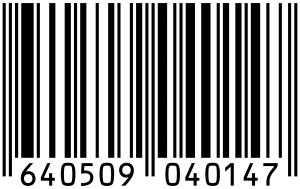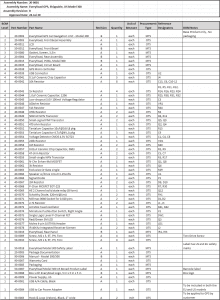Warehouse Dictionary
B2B thru Buyer

B
- B2B
- business-to-business dealings, where one business buys materials from another business
- B2C
- business-to-customer dealings, where a final customer buys from a business
- Back Order
- Product ordered but out of stock and promised to ship when the product becomes available.
- Backflush
- method for issuing (reducing on-hand quantities) materials to a production order. With backflushing, the material is issued automatically when production is posted against an operation. The backflushing program will use the quantity completed to calculate through the bill of materials the quantities of the components used, and reduce on-hand balances by these quantities.
- Backhaul
- The process of a transportation vehicle returning from the original destination point to the point of origin. The 1980 Motor Carrier Act deregulated interstate commercial trucking, thereby allowing carriers to contract for the return trip. The backhaul can be with a full, partial, or empty load. An empty backhaul is called deadheading.
- Backorder
- The act of retaining a quantity to ship against an order when other order lines have already been shipped. Backorders are usually caused by stock shortages.
- The quantity remaining to be shipped if an initial shipment(s) has been processed. Note: In some cases, backorders are not allowed. This results in a lost sale when sufficient quantities are not available to completely ship an order or order line.
- Bale
- A large compressed, bound, and often wrapped bundle of a commodity, such as cotton or hay.
- Barcode
- A symbol consisting of a series of printed bars representing values. A system of optical character reading, scanning, tracking of units by reading a series of printed bars for translation into a numeric or alphanumeric identification code. A popular example is the UPC code used on retail packaging.

Example of a UPC barcode
- Barcode Scanner
- A device to read barcodes and communicate data to computer systems.
No Results Found
The page you requested could not be found. Try refining your search, or use the navigation above to locate the post.
No Results Found
The page you requested could not be found. Try refining your search, or use the navigation above to locate the post.
No Results Found
The page you requested could not be found. Try refining your search, or use the navigation above to locate the post.
- Barcoding
- A method of encoding data for fast and accurate readability. Barcodes are a series of alternating bars and spaces printed or stamped on products, labels, or other media, representing encoded information which can be read by electronic readers called bar.
- Base Currency
- The currency whose value is “one” whenever a quote is made between two currencies.
- Basing-Point Pricing
- A pricing system that includes a transportation cost from a particular city or town in a zone or region even though the shipment does not originate at the basing point.
- Batch Terminal Communications
- The connection between the PC and Batch handheld for purposes of transferring data or WMS program setting.
- Benchmarking
- The process of comparing performance against the practices of other leading companies for the purpose of improving performance. Companies also benchmark internally by tracking and comparing current performance with past performance.
- Benefit-Cost Ratio
- An analytical tool used in public planning; a ratio of total measurable benefits divided by the initial capital cost.
- Best Practice
- A specific process or group of processes which have been recognized as the best method for conducting an action. Best practices may vary by industry or geography depending on the environment being used. Best-practices methodology may be applied with respect to resources, activities, cost object, or processes.
- Bill of Activities
- A listing of activities required by a product, service, process output, or other cost object. Bill of activity attributes could include volume and/or cost of each activity in the listing.
- Bill of Lading (BOL)
- A transportation document that is the contract of carriage containing the terms and conditions between the shipper and carrier.
- Bill of Lading Number
- The number assigned by the carrier to identify the bill of lading.
- Bill of Materials
- lists materials (components) required to produce an item. Multilevel BOMs also show subassemblies and their components. Other information such as scrap factors may also be included in the BOM for use in materials planning and costing. Commonly known as a BOM or just a Bill.
- Bill of Material Accuracy
- Conformity of a list of specified items to administrative specifications, with all quantities correct.
- Bill of Resources
- A listing of resources required by an activity. Resource attributes could include cost and volumes.
- Bin Center
- A drop off facility that is smaller than a public warehouse
- Binder
- A strip of cardboard, thin wood, burlap, or similar material placed between layers of containers to hold a stack together.
- Blanket Purchase Order
- A long-term commitment to a supplier for material against which short-term releases will be generated to satisfy requirements. Oftentimes, blanket orders cover only one item with predetermined delivery dates.
- Blanket Rate
- A rate that does not increase according to the distance a commodity is shipped.
- Blanket Release
- The authorization to ship and/or produce against a blanket agreement or contract.
- Blind Receiving
- Receiving goods in a DC without any PO or ASN is termed as blind receiving.
- Bonded Warehouse
- Warehouse approved by the Treasury Department and under bond/guarantee for observance of revenue laws. Used for storing goods until duty is paid or goods are released in some other proper manner.
- Booking
- The act of requesting space and equipment aboard a vessel for cargo which is to be transported.
- Booking Number
- The number assigned to a certain space reservation by the carrier or the carrier’s agent.
- Bottleneck
- A constraint, obstacle, or planned control that limits throughput or the utilization of capacity.
- Boxcar
- An enclosed railcar used to transport freight
- adsf asdf adsf
- Bracing
- To secure a shipment inside a carrier’s vehicle to prevent damage.
- Bracketed Recall
- Recall from customers of suspect lot numbers, plus a specified number of lots produced before and after the suspect ones.
- Break-Bulk
- The separation of a consolidated bulk load into smaller individual shipments for delivery to the ultimate consignee. The freight may be moved intact inside the trailer, or it may be interchanged and rehandled to connecting carriers.
- Break Bulk Cargo
- Cargo that is shipped as a unit or package (for example: palletized cargo, boxed cargo, large machinery, trucks) but is not containerized.
- Break Bulk Vessel
- A vessel designed to handle break bulk cargo.
- Break-Even Point
- The level of production or the volume of sales at which operations are neither profitable nor unprofitable. The break-even point is the intersection of the total revenue and total cost curves.
- Buffer
- 1) A quantity of materials awaiting further processing. It can refer to raw materials, semi-finished stores, or hold points, or a work backlog that is purposely maintained behind a work center. 2) In the theory of constraints, buffers can be time or material, and support throughput and/or due date performance. Buffers can be maintained at the constraint, convergent points (with a constraint part), divergent points, and shipping points.
- Buffer Management
- In the theory of constraints, a process in which all expediting in a shop is driven by what is scheduled to be in the buffers (constraint, shipping, and assembly buffers). By expediting this material into the buffers, the system helps avoid idleness at the constraint and missed customer due dates. In addition, the causes of items missing from the buffer are identified, and the frequency of occurrence is used to prioritize improvement activities.
- Buffer Stock
- A quantity of goods or articles kept in storage to safeguard against unforeseen shortages or demands.
- Build to Inventory
- A “push” system of production and inventory management. Product is manufactured or acquired in response to sales forecasts.
- Build to Order
- A method of reducing inventory by not manufacturing product until there is an actual order from the customer.
- Bulk Area
- A storage area for large items which at a minimum are most efficiently handled by the pallet load.
- Bulk Cargo
- Unpacked dry cargo such as grain, iron ore or coal. Any commodity shipped in this way is said to be in bulk.
- Bullwhip Effect
- An extreme change in the supply position upstream in a supply chain generated by a small change in demand downstream in the supply chain. Inventory can quickly move from being backordered to being in excess. This is caused by the serial nature of communicating orders up the chain with the inherent transportation delays of moving product down the chain. The bullwhip effect can be eliminated by synchronizing the supply chain.
- Bundling
- An occurrence where two or more products are combined into one transaction for a single price.
- Business Application
- Any computer program, set of programs, or package of programs created to solve a particular business problem or function.
- Business Logistics
- The process of planning, implementing, and controlling the efficient, effective flow and storage of goods, services, and related information from the point of origin to the point of consumption for the purpose of conforming to customer requirements.
- Business Plan
- (1) A statement of long-range strategy and revenue, cost, and profit objectives usually accompanied by budgets, a projected balance sheet, and a cash flow (source and application of funds) statement. A business plan is usually stated in terms of dollars and grouped by product family. The business plan is then translated into synchronized tactical functional plans through the production planning process (or the sales and operations planning process). Although frequently stated in different terms (dollars versus units), these tactical plans should agree with each other and with the business plan. (2) A document consisting of the business details (organization, strategy, and financing tactics) prepared by an entrepreneur to plan for a new business.
- Business Performance Measurement (BPM)
- A technique that uses a system of goals and metrics to monitor performance. Analysis of these measurements can help businesses periodically set business goals, and then provide feedback to managers on progress towards those goals. A specific measure can be compared to itself over time, compared with a present target, or evaluated along with other measures.
Business Performance Measurement by Andy Neely – cambridge.org
- Business Process Outsourcing (BPO)
- The practice of outsourcing non-core internal functions to third parties. Functions typically outsourced include logistics, accounts payable, accounts receivable, payroll, and human resources. Other areas can include IT development or complete management of the IT functions of the enterprise.
- Business Process Reengineering (BPR)
- The fundamental rethinking and radical redesign of business processes to achieve dramatic organizational improvements.
- Business Unit
- A division or segment of an organization generally treated as a separate profit-and-loss center.
- Buyer
- An enterprise that arranges for the acquisition of goods or services and agrees to payment terms for such goods or services.


